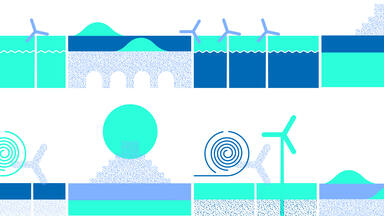Cumulative impacts can be defined as a result of several additional, often individually insignificant changes or effects. They are often neither measured nor accounted for before their effect grows progressively over time through accumulation. Although the existence of cumulative impacts is known to be omnipresent, they are often overseen in impact assessment processes.
Assessments of cumulative impacts often overlap with the assessment of indirect impacts and the evaluation of interacting impacts. Nevertheless, the assessment of indirect and cumulative impacts, and impact interactions should be based on an integrated approach throughout the impact assessment process and not thought of as a separate stage. So the assessment of such impacts should be an integral part of all stages of an impact assessment related to proposed wind energy projects.
When considering wind energy developments, the cumulative impact assessment includes both direct and indirect effects from existing elements and proposed projects and from other previous and reasonably foreseeable future changes that potentially have an impact on the OUV of a World Heritage property and its attributes. This might be:
- a new wind energy project in an area where elements/structures have already been built/implemented that in combination adds up impacts;
- a new wind energy project in combination with one or more existing or approved but unbuilt project;
- a new wind energy project in an area where other projects are planned in the reasonably foreseeable future;
- an extension to an existing or approved but unbuilt project;
- more than one wind energy project proposed at the same time within an area; or
- any combination of the above.
When to consider cumulative impacts?
Cumulative impacts of wind energy projects should be considered both
- in strategic planning mechanisms (like a Strategic Impact Assessment) as part of the preparation of a strategic framework for energy development plans or, more specifically, for a plan for the identification of suitable areas for wind energy projects; and
- in the context of site-specific planning proposals (Environmental and Social Impact Assessments).
Assessment of cumulative impacts is more effective if examined and counted with at the policy, spatial planning and strategic programme level. This is also more cost effective and timesaving as gathering relevant information may be easier at this level. Nevertheless, it requires awareness and attention from the relevant national bodies and integration of cross-sectorial thinking.
It is also to be noted that assessing cumulative impacts in relation to a World Heritage property can be conflicting with national legislations, which often follow the principle that each project application must be determined on its own ‘individual merit’. For this reason, decision-makers should seek opportunities to reconcile multiple interests when assessing impacts of wind energy projects.
The basic tool for all cumulative impact assessment is the identification of thresholds (at the local, regional and national level) to reflect the significance of impacts on OUV and attributes. The key principle for a cumulative impact assessment related to individual wind energy project proposals is to focus on their likely impact on the OUV of a respective World Heritage property.
How could thresholds be set for World Heritage properties?
Setting thresholds at any level may be a challenging exercise and the result may often be conceptual rather than exact numerical quantities to work with. Nevertheless, the nomination dossier proposed during the inscription of a site to the World Heritage List might provide valuable information from this point of view. The value centred approach should be exercised for this process as well, using the set baselines of the impact assessment process (like, for example, the state of conservation of the site at the time of inscription on the World Heritage List).
Experts should engage in this process with stakeholders and synthesize input with their professional judgement. Any methodology employed for the cumulative assessment should be rigorous (and well-described in the impact assessment documents) and transparent.
Potential cumulative impact of wind energy projects (both onshore and offshore)
Cumulative impacts can emerge in diverse forms. They can result from the accumulation of impacts derived from the installation of multiple wind or renewable energy projects, the multiple facilities of an onshore or offshore wind energy project, the continuous enlargement of an existing wind energy facility, or multiple infrastructural developments and wind projects together.
Examples on potential impacts that can accumulate concerning wind energy projects:
- visual impact of wind turbines should be considered especially if a wind farm is developed progressively, always adding only a few new turbines to the existing ones. Relevant factors can be:
- the distance between individual windfarms (or turbines);
- the distance over which they are visible.
- Visual impact of a wind farm together with other visually adverse elements of a landscape. Relevant factors can be:
- the overall character of the landscape and its sensitivity to windfarms;
- scale and grain of landscape mosaic;
- the location and axis of significant views;
- the siting and design of the windfarms themselves; and
- the way in which the landscape is experienced.
- Visual impact of ancillary facilities, where relevant factors can be both visual and functional, adding also to those of the wind farm itself.
Other types of impacts can be related to the operation and maintenance of wind farms and their ancillary facilities (especially concerning natural World Heritage properties).
Case studies
There are several guidance documents and examples of Cumulative Impact Assessments. The Canadian Environmental Assessment Agency has developed a Cumulative Effects Assessment Practitioners’ Guide to support the development of cumulative assessments in line with the Canadian Environmental Assessment Act of 2012.
